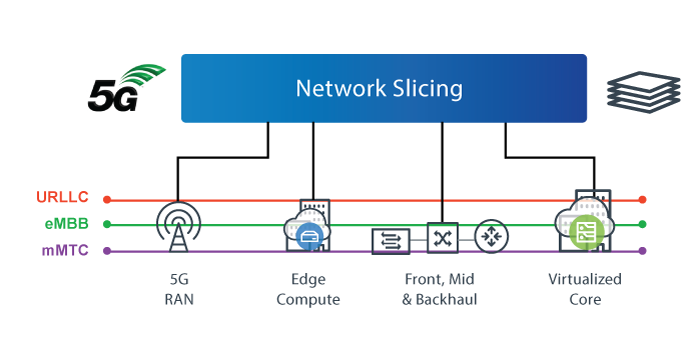What Is 5G Network Slicing?
5G network slicing allows the creation of multiple unique logical and virtualized networks over a common 5G infrastructure. It is one of the most important advantages of 5G technology because it enables concurrent support for new services with vastly different requirements—from a connected vehicle to a voice call—over a common network infrastructure.
The use cases identified for 5G and network slicing fall into three major categories:
- Enhanced Mobile Broadband (eMBB) use cases which are high-bandwidth, video-centric, and generate the most traffic on a mobile network.
- Internet of Things (IoT) use cases, supported by massive Machine Type Communication (mMTC), connecting billions of devices to the network .
- Ultra-reliable Low-Latency Communications (urLLC) use cases that address activities like remote surgery or vehicle-to-X (v2x) communication, which require edge computing to reduce latency.

While functional components and resources may be shared across network slices, capabilities such as data speed, capacity, connectivity, quality, latency, reliability, and services can be customized in each slice to conform to a specific Service Level Agreement (SLA).
Automation and Network Slicing
Automation is needed to effectively implement network slicing at scale—because designing, fulfilling, and assuring hundreds or thousands of network slices end to end across Radio Access Network (RAN), transport, and 5G Core domain is too complex to be accomplished by manual means. Automation is also needed to meet customer demands for rapid slice-based service activation—including on-demand services—which cannot be accomplished using legacy operational processes and manual intervention.
How Blue Planet can help
Blue Planet provides open, modular, and cloud-native 5G automation solutions that address every stage of the 5G journey, including support for vendor-agnostic network slicing automation. This solution automates the entire slice lifecycle, from design and activation, through monitoring and assurance—and even termination, enabling the efficient reuse of valuable network resources.
With Blue Planet, network operators can quickly create end-to-end network slices in support of a specific application, service, set of users, or network—including on-demand slices requested by enterprise and consumer customers via a self-service portal.
Learn more about the Blue Planet 5G Automation solution.
